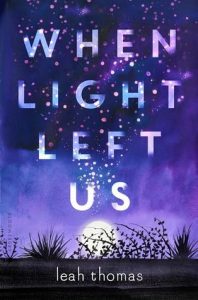
Leah Thomas
Bloomsbury
Published on February 13, 2018

Amazon | Barnes & Noble | Goodreads
About When Light Left Us
When the Vasquez siblings’ father left, it seemed nothing could remedy the absence in their lives . . . until a shimmering figure named Luz appeared in the canyon behind their house.
Luz filled the void. He shot hoops with seventeen-year-old Hank’s hands. He showed fourteen-year-old Ana cinematic beauty behind her eyelids. He spoke kindly to eight-year-old Milo. But then Luz left, too, and he took something from each of them. As a new school year begins, Ana, Hank, and Milo must carry on as if an alien presence never altered them. But how can they ever feel close to other people again when Luz changed everything about how they see the world and themselves?
In an imaginative and heartfelt exploration of human—and non-human—nature, Leah Thomas champions the unyielding bonds between family and true friends.
My Review
When Light Left Us is a really odd book. Some of the oddness kind of made it hard for me to get into the story at first. I liked all three of the kids, though, so as I got to know them, I got more into the story. The writing is amazing. Even when the plot didn’t hook me, I would find myself lost in the stark descriptions of things, especially of the emotions of the characters. Thomas finds these really powerful and often unorthodox ways of describing things that is like tossing you into a swimming pool of that emotion. Suddenly, you’re swallowed up by feelings. I loved that about her earlier books and found it to be equally true in this one, too.
I liked that the siblings had really distinct traits and ways of thinking and talking. Ana with her sarcasm and Hank with his uncertainty. Milo with his helium-filled optimism. So great! I wasn’t crazy about the fact that their mom had her own point-of-view scenes at first, but it did add to the story. I’m not sure if teen readers would connect with her the same way that I did as a mom, though. Lots of the things she said and did resonated with me.
All in all, the story never gets un-weird. A strange alien-ish creature changes the lives of the humans it contacts. They must fight their way back from the trauma of losing their dad and then losing contact with the alien presence. But the characters, the power of the storytelling make When Light Left Us a strong, unforgettable story.
Cultural Elements
Hank, Ana, and Milo’s dad is Mexican and their mom is white. Hank is gay.
Profanity/Crude Language Content
Extreme profanity used infrequently.
Romance/Sexual Content
Kissing and references to kissing between a boy and girl and a boy and boy.
Spiritual Content
Luz is possibly an alien or other sentient being who communicates with his hosts and can take control of their bodies.
Violent Content
Hank remembers attacking two people and trying to choke them. Ana has a history of cutting herself and briefly remembers some of those experiences. A boy attacks Hank, punching and kicking him. Luz seems fascinated with death and nearly forces two people to end their lives while he controls them.
Drug Content
None.